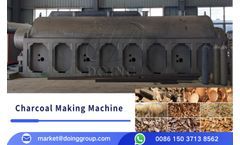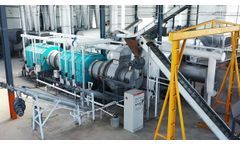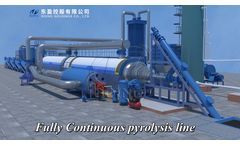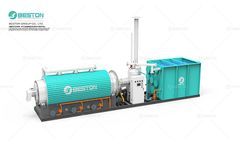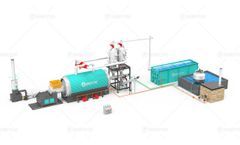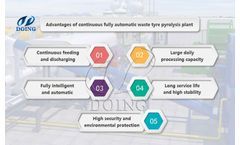Pyrolysis Plants Over Batch Systems Articles & Analysis
54 articles found
Catalytic pyrolysis has emerged as a pivotal advancement in thermal conversion technologies, particularly for transforming complex hydrocarbon feedstocks into higher-value liquid fuels. By incorporating specialized catalysts into the pyrolysis process, industrial operators can significantly improve oil yield, enhance product quality, and optimize energy efficiency. This methodology is ...
Transforming organic waste into a functional, high-value additive has become central to sustainable waste management and regenerative agriculture. Biochar production technologies have matured significantly, allowing for the controlled conversion of biomass into a carbon-rich material with wide-ranging applications. At the forefront of this evolution is the biomass pyrolysis plant for sale, an ...
Shift from Batch to Continuous Operation Traditional batch pyrolysis reactor, while effective for small-scale or experimental use, face limitations in throughput and energy optimization. The industry is increasingly shifting toward continuous pyrolysis systems, which offer uninterrupted feedstock input and ...
As global emphasis on energy efficiency intensifies, advancements in pyrolysis technology have shifted toward optimizing heat utilization and minimizing energy loss. Central to this evolution is the refinement of continuous pyrolysis plant design, which now integrates cutting-edge reactor engineering to enhance thermal performance, throughput, and system longevity. Evolution of Reactor ...
Pyrolysis reactors play a crucial role in the conversion of waste materials into useful products, such as bio-oil, syngas, and char. Whether you are considering investing in a pyrolysis reactor for industrial purposes or as part of a waste-to-energy project, it's essential to understand the key components of these reactors and the factors to consider when purchasing one. This blog will provide an ...
Biochar production from waste coconut shells has garnered increasing attention as a sustainable business model that not only contributes to environmental conservation but also offers substantial economic benefits. As the demand for renewable resources and waste-to-energy technologies grows, the profitability of biochar production has become an important consideration for businesses and investors ...
The global ocean plastic pollution crisis has reached a critical point. Every year, millions of tons of plastic waste end up in the oceans, threatening marine life, disrupting ecosystems, and creating long-term environmental consequences. Traditional waste management and recycling methods have proven insufficient in addressing the sheer volume of plastic waste, particularly in coastal regions and ...
The quality of barbecue charcoal is paramount for a superior grilling experience. High-quality charcoal ensures consistent heat, minimal smoke, and extended burn time, which are crucial for grilling food to perfection. Achieving the desired quality requires attention to various factors during both the production and processing stages. From raw material selection to machine efficiency, several ...
Pyrolysis is a thermal decomposition process that breaks down organic materials, such as plastic, rubber, and biomass, in the absence of oxygen. This process has gained significant attention for its potential in waste management and resource recovery, offering an effective way to convert waste into valuable products like fuel, gas, and biochar. A key question that often arises is whether ...
The biomass continuous carbonization furnace is an efficient and environmentally friendly equipment for the thermochemical conversion of biomass resources. The whole set of continuous carbonization furnace converts biomass into charcoal by controlling the temperature, pressure and gas of the carbonized material. The whole set of processing technology of the continuous carbonization furnace ...
The operation of biochar production equipment involves a series of meticulously controlled processes that transform organic biomass into a valuable byproduct. Biochar, a stable form of carbon, is created through the thermochemical conversion of organic materials in the absence of oxygen, commonly referred to as pyrolysis. This process not only reduces waste but also yields a product that has ...
The thermal efficiency of a pyrolysis reactor is a critical factor in determining the overall performance, energy consumption, and economic feasibility of the pyrolysis process. Pyrolysis, a thermochemical decomposition process, is used to convert organic materials such as plastics, rubber, and biomass into valuable products like oil, gas, and charcoal. The efficiency with which the reactor ...
A continuous pyrolysis plant is designed to streamline the conversion of waste materials, such as plastics and tires, into valuable resources like fuel oil, carbon black, and syngas. Understanding its operating cycle time is essential for businesses and operators to achieve efficiency, maximize output, and make informed decisions about processing volumes, energy usage, and maintenance scheduling. ...
The biomass fraction of pyrolysis refers to the portion of biomass material that undergoes thermal decomposition in the pyrolysis process to produce valuable products such as biochar, bio-oil, and syngas. This fraction is significant in determining the efficiency and output of a pyrolysis system. Key Aspects of the Biomass Fraction in Pyrolysis 1. Composition: Biomass is primarily composed of ...
Continuous pyrolysis machines are gaining popularity over batch-type pyrolysis machines for several reasons. Here’s a comprehensive look at why continuous systems are preferred in many applications: 1. **Higher Efficiency and Throughput** - **Constant Operation**: Continuous pyrolysis machines can operate 24/7, processing feedstock without the need for downtime between batches. This leads ...
When considering investment options for pyrolysis technology, opting for small-scale pyrolysis equipment can be a practical choice, especially if your business processes a limited amount of organic materials. Large-scale pyrolysis plants are often more suitable for higher volume operations, so starting with a smaller unit might be more cost-effective and practical. Here’s why small-scale ...
The mini pyrolysis plant represents a significant opportunity for investors looking to enter the waste-to-energy sector. By converting waste materials such as plastics, tires, and biomass into valuable by-products, mini pyrolysis plants offer a sustainable solution to waste management while generating potential revenue streams. Understanding the investment scenario for a mini pyrolysis plant ...
The pursuit of sustainable energy sources has intensified as the world grapples with the dual challenges of waste management and energy security. Plastic pyrolysis, a method of converting plastic waste into valuable fuels, has emerged as a significant alternative fuel production solution. This process addresses both environmental and energy concerns by transforming plastic waste into usable ...
Continuous carbonization furnace is an efficient and environmentally friendly equipment for the thermochemical conversion of biomass resources. The whole set of continuous carbonization furnace converts biomass into charcoal by controlling the temperature, pressure and gas of the carbonized material. The whole set of processing technology of the continuous carbonization furnace includes four ...
In our modern world, waste management has become a pressing global challenge, particularly with the proliferation of non-biodegradable materials like tires and plastics. Continuous pyrolysis equipment, a cutting-edge technology, offers a sustainable solution by converting waste materials into valuable resources such as fuel, chemicals, and raw materials. In this comprehensive guide, we Henan ...









